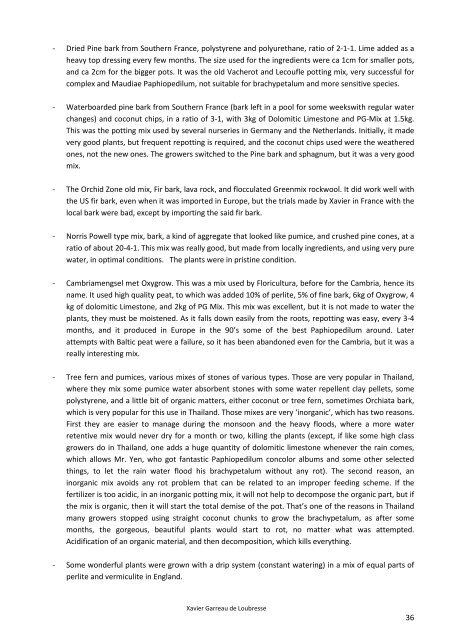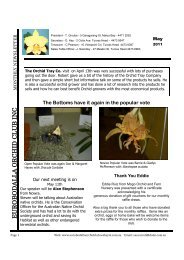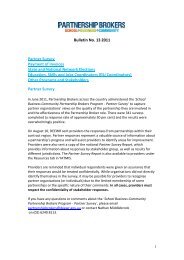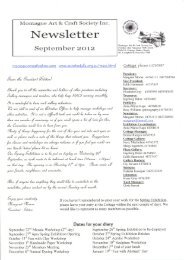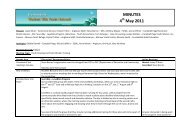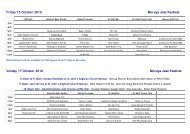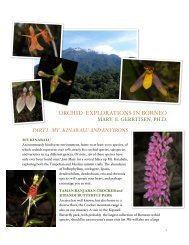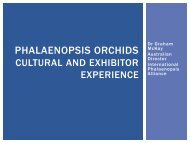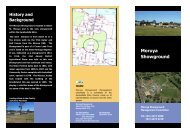Orchid Growing Substrates
Orchid Growing Substrates
Orchid Growing Substrates
You also want an ePaper? Increase the reach of your titles
YUMPU automatically turns print PDFs into web optimized ePapers that Google loves.
- Dried Pine bark from Southern France, polystyrene and polyurethane, ratio of 2-1-1. Lime added as a<br />
heavy top dressing every few months. The size used for the ingredients were ca 1cm for smaller pots,<br />
and ca 2cm for the bigger pots. It was the old Vacherot and Lecoufle potting mix, very successful for<br />
complex and Maudiae Paphiopedilum, not suitable for brachypetalum and more sensitive species.<br />
- Waterboarded pine bark from Southern France (bark left in a pool for some weekswith regular water<br />
changes) and coconut chips, in a ratio of 3-1, with 3kg of Dolomitic Limestone and PG-Mix at 1.5kg.<br />
This was the potting mix used by several nurseries in Germany and the Netherlands. Initially, it made<br />
very good plants, but frequent repotting is required, and the coconut chips used were the weathered<br />
ones, not the new ones. The growers switched to the Pine bark and sphagnum, but it was a very good<br />
mix.<br />
- The <strong>Orchid</strong> Zone old mix, Fir bark, lava rock, and flocculated Greenmix rockwool. It did work well with<br />
the US fir bark, even when it was imported in Europe, but the trials made by Xavier in France with the<br />
local bark were bad, except by importing the said fir bark.<br />
- Norris Powell type mix, bark, a kind of aggregate that looked like pumice, and crushed pine cones, at a<br />
ratio of about 20-4-1. This mix was really good, but made from locally ingredients, and using very pure<br />
water, in optimal conditions. The plants were in pristine condition.<br />
- Cambriamengsel met Oxygrow. This was a mix used by Floricultura, before for the Cambria, hence its<br />
name. It used high quality peat, to which was added 10% of perlite, 5% of fine bark, 6kg of Oxygrow, 4<br />
kg of dolomitic Limestone, and 2kg of PG Mix. This mix was excellent, but it is not made to water the<br />
plants, they must be moistened. As it falls down easily from the roots, repotting was easy, every 3-4<br />
months, and it produced in Europe in the 90’s some of the best Paphiopedilum around. Later<br />
attempts with Baltic peat were a failure, so it has been abandoned even for the Cambria, but it was a<br />
really interesting mix.<br />
- Tree fern and pumices, various mixes of stones of various types. Those are very popular in Thailand,<br />
where they mix some pumice water absorbent stones with some water repellent clay pellets, some<br />
polystyrene, and a little bit of organic matters, either coconut or tree fern, sometimes Orchiata bark,<br />
which is very popular for this use in Thailand. Those mixes are very ‘inorganic’, which has two reasons.<br />
First they are easier to manage during the monsoon and the heavy floods, where a more water<br />
retentive mix would never dry for a month or two, killing the plants (except, if like some high class<br />
growers do in Thailand, one adds a huge quantity of dolomitic limestone whenever the rain comes,<br />
which allows Mr. Yen, who got fantastic Paphiopedilum concolor albums and some other selected<br />
things, to let the rain water flood his brachypetalum without any rot). The second reason, an<br />
inorganic mix avoids any rot problem that can be related to an improper feeding scheme. If the<br />
fertilizer is too acidic, in an inorganic potting mix, it will not help to decompose the organic part, but if<br />
the mix is organic, then it will start the total demise of the pot. That’s one of the reasons in Thailand<br />
many growers stopped using straight coconut chunks to grow the brachypetalum, as after some<br />
months, the gorgeous, beautiful plants would start to rot, no matter what was attempted.<br />
Acidification of an organic material, and then decomposition, which kills everything.<br />
- Some wonderful plants were grown with a drip system (constant watering) in a mix of equal parts of<br />
perlite and vermiculite in England.<br />
Xavier Garreau de Loubresse<br />
36


